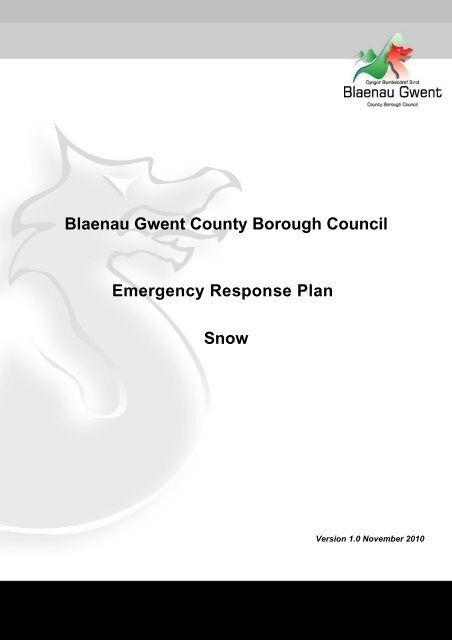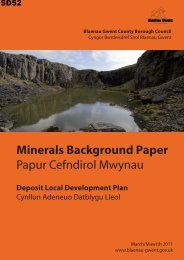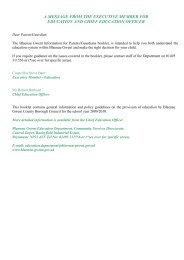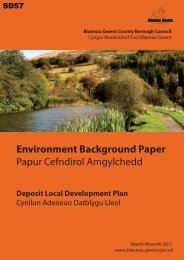severe weather incident team - Blaenau Gwent County Borough ...
severe weather incident team - Blaenau Gwent County Borough ...
severe weather incident team - Blaenau Gwent County Borough ...
You also want an ePaper? Increase the reach of your titles
YUMPU automatically turns print PDFs into web optimized ePapers that Google loves.
60<strong>Blaenau</strong> <strong>Gwent</strong> <strong>County</strong> <strong>Borough</strong> CouncilEmergency Response PlanSnowVersion 1.0 November 2010
ACTIVATION FLOW CHART- INITIATION OF RESPONSEA Severe Weather Incident Team will be activated if there is an expectation that the<strong>weather</strong> conditions will cause disruption to the local community.The Severe Weather Incident Team will initially be coordinated by the Principal CivilContingencies Coordinator.Duty WinterMaintenanceForeman –notification of poorroad conditionsMet Office / PWSWeather WarningNotification fromPartner AgenciesDuringoffice hoursOut ofhoursPrincipal CivilContingenciesCoordinator / CivilContingenciesTeamDistribution ofWarningsWorcester TelecareEmergencyPlanningDuty OfficerThe Civil Contingencies Team / Emergency Planning Duty Officer will make an assessment ofthe alert / warning to determine whether further action is required, taking into account:• Current <strong>weather</strong> and road conditions• Current gritting / salting of the network that has been carried out• The opportunity to provide further gritting / salting, and whether this is practical in thecircumstances• Potential impact of the <strong>weather</strong> conditions• Discussions with senior officers / DirectorIf a <strong>weather</strong> forecast / warningindicates the <strong>weather</strong> conditionsmay cause disruption:CC Team / EP DO to followstandby procedures as inAppendix 1If a <strong>weather</strong> forecast / warningindicates the <strong>weather</strong> conditionsare likely to cause disruption:CC Team / EP DO to follow fullactivation procedures as inAppendix 12
Contents1. INTRODUCTION1.1 Aim of the Plan1.2 Objectives of the Plan1.3 Definition of Severe Weather1.4 Impact of Snow and Ice Conditions55662. INITIATION OF RESPONSE2.1 Weather and Information Services2.1 Activating the Severe Weather Plan793. ROLES AND RESPONSIBILITIES3.1 Emergency Response Structure3.2 Roles and Responsibilities1111APPENDICESAppendix 1 – Severe Weather Incident Team Action Checklists andGuidance17Appendix 2 – Critical Infrastructure 25Appendix 3 – Severe Weather Incident Team Contacts 32Appendix 4 – Risk 33Appendix 5 – Advice On Clearing Snow And Ice From Pavements 34Appendix 6- Key Links 35Appendix 7 - Business Continuity 36Appendix 8 – Protocol For Closure Of Roads – Highways / PoliceLiaisonAppendix 9 – Disruptive Snow Conditions – Communications andCommunity Confidence Plan3738Appendix 10 – Incident Log Sheet 424
Distribution ListChief ExecutiveCMTCivil Contingencies TeamC2BGWorcesterAll ‘Silver’ officers (see the Emergency Management Plan)Highways and TransportationSocial ServicesEducationMembers LibraryVersion ControlNumber Comments Date Approval1.0 Original version - DCG November2010Environment DepartmentalManagement Team 9/11/105
1 INTRODUCTIONSevere <strong>weather</strong> is not unusual in the UK and occurs a number of times each year, mostcommonly in winter. Whilst it affects the areas where it occurs the impact is not usuallyserious. Extreme <strong>weather</strong> is unusual and perhaps only occurs 3-4 times each yearnationally. It can have a significant impact on infrastructure and casualties may result.1.1 Aim of the PlanThis plan has been produced to define the framework for the Local Authority responseto <strong>severe</strong> snow conditions and incorporates an escalating response according to<strong>weather</strong> conditions and its impact.The plan complements the Corporate Emergency Management Plan, <strong>Blaenau</strong> <strong>Gwent</strong>Winter Maintenance Plan, and <strong>Gwent</strong> Multi Agency Emergency Response Plan.This plan provides a framework for the activation, allocation and deployment of Councilresources in the event of snow conditions. The aim of this plan is to enable the LocalAuthority’s resources to be speedily mobilised to deal with any predicted or actual<strong>severe</strong> <strong>weather</strong> emergency, or to render mutual aid to other <strong>Gwent</strong> Local ResilienceForum (GLRF) member agencies in dealing with snow conditions.In the event of invocation of the Corporate Severe Weather Plan, and the correspondingSnow Plan, the Council will seek to:• Identify those areas most likely to be affected.• Implement actions as identified in this plan, and Directorate Plans• Give priority to vulnerable areas and people• Work closely with partner organisations in our response to the <strong>incident</strong>.• Provide full information at the earliest opportunity to those likely to be affected by thedisruption, including residents of <strong>Blaenau</strong> <strong>County</strong> <strong>Borough</strong> Council, staff andMembers of the Council, other agencies and the media.1.2 Objectives of the PlanThe objectives of the Snow Plan are;• To develop the council strategy for dealing with snow conditions• To ensure activation at the appropriate level within the Council at the initial stages ofsnow conditions and coordinated management of the response• To detail the roles and responsibilities of those involved in response to snowconditions• To ensure a coordinated approach with partners, where required• To provide a detailed list of actions to cover the activation and initial period followingnotification of potential disruptive snow conditions.6
1.3 Definition of Severe WeatherFor the purposes of this plan, <strong>severe</strong> <strong>weather</strong> can be defined as:Severe or hazardous <strong>weather</strong> which could cause problems, ranging fromwidespread disruption of communications to conditions resulting in transportdifficulties or threatening lives.(Met Office National Severe Weather Warning Service)1.4 Impact of Snow and Ice ConditionsWarnings are issued using a set of fixed <strong>weather</strong> criteria for the whole of the UKMet Office criteriaHeavysnowVery heavysnowSnow falling at a rate of 2 cm/hour or more expected for at least 2 hours.Potential Implications: Increased journey times, Minor accidentsSnow falling at a rate of 2 cm/hour or more expected for at least twohours, accumulating to 15 cm or more.Potential Implications: Local routes impassable, Local loss of powerand telecommunication linesBlizzardModerate or heavy snow accompanied by winds of 30 m.p.h. or more,with visibility reduced to 200m or less; or drifting snow giving rise tosimilar conditions.Potential Implications: Major routes impassable, Local loss of powerand telecommunication linesSevereblizzardHeavy Snow accompanied by winds of 30 m.p.h. or more, reducingvisibility to near zero.Potential Implications: Transport infrastructure paralysed, Regionalloss of power and communication linesWidespreadicy roads,glazedfrost,freezingrainWhen rain falls onto surfaces with temperatures at or below zero; orcondensation occurs on surfaces at or below zero; or already wetsurfaces fall to or below zero. The ice is usually clear and difficult todistinguish from a wet surface. It usually forms in sheets.Warnings are issued when any depth of ice is expected over awidespread area.Potential Implications: Damage to power and telecommunication lines,Driving difficulties, Difficulty when walking7
2 INITIATION OF RESPONSE2.1 Weather and Information Services2.1.1 Met OfficeThe Met Office is the UK’s National Weather Service. Using National Severe WeatherWarning Service (NSWWS), the Met Office sends warnings to <strong>Blaenau</strong> <strong>Gwent</strong> <strong>County</strong><strong>Borough</strong> Council and Worcester Telecare via fax messages, e-mails and telephonecalls.National Severe Weather Warning ServiceThe Met Office operates the National Severe Weather Warning Service. This service ispublically available and warns the community through the provision of warnings of<strong>severe</strong> or hazardous <strong>weather</strong>, which can cause problems ranging from widespreaddisruption of communications to conditions resulting in transport difficulties or threat tolife.Depending on the severity of impending <strong>weather</strong> conditions, the Met Office will issueone or more of the following warnings (not necessarily in this order)WEATHERWATCHEARLYWARNINGFLASHWARNINGA Weather Watch is issued if there is a risk of <strong>severe</strong> <strong>weather</strong> but thelikelihood of an occurrence is not sufficient to warrant the issue of anEarly Warning or a Flash Warning. If the likelihood increases, an EarlyWarning or a Flash Warning may follow the Weather Watch.An Early Warning is issued up to several days in advance of an expectedevent.A Flash Warning, which is more immediate, is issued several hours inadvance of the event. It gives more detailed timings and movement ofthe expected event. In exceptional circumstances an Emergency FlashWarning will be issued.Met Office Public Weather AdvisorThe Met Office provides a range of information under the Public Weather Service(PWS), which is funded by the UK Government. This includes generating everythingfrom day-to-day site-specific forecasts to long-range forecasts. They are alsoresponsible for the National Severe Weather Warning Service, which aims to giveadvance warning of extreme <strong>weather</strong> to the public, businesses, emergency services andGovernment.Open Road ForecastOpen Road on the web is an online <strong>weather</strong> forecasting package supplied by the MetOffice that is designed to help minimise the effects of <strong>weather</strong> on the roads. Byproviding all key road <strong>weather</strong> information in a clear format, it enables road decisionmakersto do their jobs more easily, more cost-effectively and with greater confidence.8
2.1.2 Positive Weather Solutions (PWS)Positive Weather Solutions are an independent <strong>weather</strong> forecasting company for thewhole of the UK. <strong>Blaenau</strong> <strong>Gwent</strong> CBC has a contract with PWS to provide <strong>weather</strong>forecasts, and <strong>weather</strong> warnings as necessary.2.1.3 Weather Forecasts and WarningsThe current <strong>weather</strong> forecast contracts are with the Met Office in Cardiff, and PositiveWeather Solutions. The contracts provide forecast and support services. Warnings areissued as necessary.FORECASTTIMERECEIVEDPERIODMet Office – Morning Summary 0730 October to March inclusive.Met Office – 2-5 day outlook 0900 October to March inclusive.Met Office – 24 hour 1230 October to March inclusive.PWS – Weekly <strong>weather</strong> report Sunday April – mid October inclusivePWS – Daily <strong>weather</strong> report 1830 April – mid October inclusiveMet Office Contacts:REMOVED FROM PUBLICALLY AVAILABLE VERSIONPWS Contacts:REMOVED FROM PUBLICALLY AVAILABLE VERSION2.1.4 Distribution of Weather WarningsDuring office hours, 08:00 – 17:00 the Civil Contingencies Team will receive the<strong>weather</strong> warnings. These will be distributed to the ‘Severe Weather WarningDistribution List’ held by the Civil Contingencies Team.Outside office hours, Worcester Telecare will receive these warnings and distribute asrequested. Weather Warnings will also be passed to the Emergency Planning DutyOfficer out of hours.9
2.2 Activation ProceduresA Severe Weather Incident Team is an operational <strong>team</strong> where a Tactical EmergencyResponse Team (ERT) is not required. In any <strong>incident</strong> where an ERT is not set up, theCivil Contingencies Team will coordinate the Local Authority response to the <strong>incident</strong>.In the event of a larger scale adverse <strong>weather</strong> <strong>incident</strong> where the Severe WeatherIncident Team is established, Silver officers may be mobilised and will adopt thecoordinating role, relative to the adverse <strong>weather</strong> that is occurring.For smaller adverse <strong>weather</strong> <strong>incident</strong>s the Principal Civil Contingencies Coordinator willretain this coordinating role.A Severe Weather Incident Team will be established if the conditions meet the followingcriteria:There is an expectation that the <strong>weather</strong> conditions will cause disruption to thelocal community.2.2.1 Trigger for ActivationIn the event of receipt of a warning from any of the agencies, the Civil ContingenciesTeam will make an assessment of the alert / warning to determine whether furtheraction is required, taking into account:• Current <strong>weather</strong> and road conditions• Current gritting / salting of the network that has been carried out• The opportunity to provide further gritting / salting, and whether this is practical in thecircumstances• Traffic volumes and number of vehicles that could be isolatedInitial further actions may consist of:• A follow-up call / email with the issuing agency• Telephone discussion with senior officers to agree further actions/monitoring• Activation of Departmental Severe <strong>weather</strong> plans• Putting the Severe Weather Team on Alert / Standby or ActivationAn Emergency Response Team may also be required. If one or more of the followingcriteria are met, the Chief Executive, (or in his absence, a Director), should beconsulted and consideration given to the establishment of an Emergency ResponseTeam, (ERT), together with other elements of the response structure, as appropriate:• if the Police declare an emergency and request the Council’s assistance• if, despite an emergency not being declared, a joint agency control is established andAuthority representation is requested• if the demands on the Authority, or any Directorate, require special arrangements forDirectorates to work together• if an <strong>incident</strong> occurs that causes widespread disruption to the local community• if an <strong>incident</strong> occurs that is likely to generate large-scale media/public interest.10
2.2.2 Alert and Standby ProceduresAdvise / AlertOn receipt of <strong>weather</strong> warnings, the Civil Contingences Team (during office hours) willdistribute the warnings to the Severe Weather Distribution List held by the CivilContingencies Team.Outside office hours, Worcester Telecare will receive these warnings and distribute asrequested. Weather warnings will also be passed to the Emergency Planning DutyOfficer out of hours.The Civil Contingencies Team / EP Duty Officer will make an assessment of the alert /warning to determine whether further action is required (see Trigger for Activation)Standby (Part Activation)If, following discussions with the issuing agency or Senior Officers, it is felt that aSevere Weather Incident Team may be necessary, the Civil Contingencies Team / EPDuty Officer will:• Contact the Severe Weather Incident Team members to advise of the situation, andthe potential for setting up the Team.• Contact C2BG to advise of the situation• Contact Worcester Telecare (out of hours) to advise of the situation• Contact the Communications Team to advise of the situationFull Activation ProceduresIf, following discussions with the issuing agency or Senior Officers, it is felt therequirements for a Severe Weather Incident Team are met (see Triggers for Activation),the Civil Contingencies Team / EP Duty Officer will:• Contact the Severe Weather Incident Team members to advise of the situation, andthe requirement for setting up the Team.• Arrange transport as necessary for the Team.• Contact C2BG to advise of the situation• Contact Worcester Telecare (out of hours) to advise of the situation• Contact the Communications Team to advise of the situation• Contact the Depot Supervisor (out of hours) for access to the Emergency Centre inthe Central Depot.• Advise CMT of the activation of the Severe Weather Incident Team• Advise Emergency Services of the activation of the Severe Weather Incident TeamDetailed Activation Procedures for use by the Civil Contingencies Team /Emergency Planning Duty Officers are included at Appendix 1.11
3 ROLES AND RESPONSIBILITIES3.1 Emergency Response StructureFor details of the Councils Emergency Response Structure, please refer to theEmergency Management Plan.3.2 Roles and ResponsibilitiesOnly officers / services allocated specific roles or having specific skills and expertise inrelation to disruptive snow conditions are covered in the following section.Emergency Response Team• Depending upon the scale of the <strong>incident</strong>, an Emergency Response Team may beactivated. The role of the Emergency Response Team (ERT) is:• Discharge roles and responsibilities as detailed in the Council’s EmergencyManagement Plan.• ensuring strategic matters are considered by CMT• coordinating provision of the Authority’s services• directing and ensuring appropriate allocation of staff and resources• ensuring the Authority is represented at Silver and Bronze level• ensuring effective information and communication systems are in place for liaisonbetween all elements of the Authority’s Emergency Management Structure includingrepresentation on joint-agency groups• ensuring that the ‘Information Officer’ is included as an integral member of the <strong>team</strong>and kept regularly updated with current information and developments• Convene the Team periodically to ensure co-ordination, provide updates on thesituation and establish priorities;• Confirm that all necessary steps have been taken to provide for the care of the publicand welfare of staff, in accordance with guidance and agreed policy withinDirectorate Emergency Plans12
Civil Contingencies Team / Emergency Planning Duty Officer• Distribution of <strong>weather</strong> warnings during office hours• Assessment of warnings received to determine whether further action is required.• Confirm known details with the emergency services and/or other externalorganisations• Ensure the Communications Team are aware of the situation and the EmergencyInformation Structure is implemented.• Ensure that steps are taken to provide any immediate services requested• If required, contact the Severe Weather Incident Team members (see Appendix 3) toadvise of the situation, and the activation level (standby / full activation)• Where appropriate, recommend to CMT / Senior Officers that the Severe WeatherPlan is activated, and the Severe Weather Incident <strong>team</strong> established• Setting up of the Emergency Centre for the Severe Weather Incident Team ifnecessary• Coordinate the Local Authority response to the <strong>incident</strong> (Severe Weather IncidentTeam) if Emergency Response Team has not been activated• Coordinate the operational deployment of staff to critical locations for snow clearance• Informing CMT, Emergency Services, Emergency Planning Liaison Officers,Emergency Planning Duty Officers, C2BG, Worcester Telecare and theCommunications Team that a Severe Weather Incident Team has been set up.• Ensure Elected Members are briefed as appropriate.• Liaison with Emergency services and voluntary sector• Co-ordination of voluntary agency(ies) and military support at the request of the ERT.When engagement has been established, the Civil Contingencies Team will handover the management of this support to the ERT.• Identification of, and consideration for those made vulnerable by the emergency• Liaison with other Local Authorities (if cross-border <strong>incident</strong>) / WAG• Consider the requirement for Mutual Aid, and notify CMT• Consider the criteria for activation of the Emergency Management Plan andestablishment of the ERT in consultation with the Chief Executive or appropriatesenior officer.• establish liaison with relevant Directorates and support the activation and operationof an ERT (where necessary)• Discharge roles and responsibilities as detailed in the Council’s EmergencyManagement Plan and individual Annexes of this plan.• Hold a debrief of the <strong>incident</strong> and write up <strong>incident</strong> report with recommendations13
Communications Team• Member of the Severe Weather Incident Team / ERT• Activation of the Communication Plan (see Appendix 9)• Provide media statements and press releases in conjunction with other respondingagencies.• Monitor and record media sources for information and ensure this is fed to theSevere Weather Incident Team for onward communication and dissemination.• If the Emergency Communications Structure is implemented, the CommunicationsTeam will act as the ‘hub’ for internal information dissemination, ensuring employeesare appropriately briefed concerning the forecast / actual adverse <strong>weather</strong> and thewider Council response.Worcester Telecare (Out Of Hours Contact Centre)• Prompt distribution of <strong>weather</strong> warnings out of hours.• Refer winter maintenance calls and requests to the duty highways crews.• Advise the Duty Emergency Planning Officer if an unusually high number of calls arereceived relating to <strong>weather</strong> conditions.C2BG• Provision of a dedicated helpline if necessary• Monitor calls for a pattern as a high level of calls from one particular area mayindicate a localised problem• Provision of a 24/7 service if necessary• Emergency Website, Twitter, Facebook and Looking Local updatesSilver Representatives• In the event of a larger scale adverse <strong>weather</strong> <strong>incident</strong> where the Severe WeatherIncident Team is established, Silver officers may be mobilised to adopt thecoordinating role, relative to the adverse <strong>weather</strong> that is occurring.Refuse / Recycling / Grounds Maintenance / Street Cleansing / LAMS• Redeployment into snow clearance as necessary14
Highways and Transportation• Member of the Severe Weather Incident Team / ERT• Out of hours - Duty Foremen receive <strong>weather</strong> forecasts via Blackberry and decide onthe necessary operational response• Resources – ensure adequate stocks of salt and instigate changes to spread rates• Arrange for all 4 x 4 vehicles to be returned to the Central Depot for re-allocation• Priority gritting routes – determine when Priority 1 gritting routes are activated• Determine when road conditions are suitable for transport based services to operate.• Road closures as necessary for safety reasons• Attend emergency <strong>incident</strong>s as requestedSocial Services• Member of the Severe Weather Incident Team / ERT• Identification of, and consideration for those made vulnerable by the emergency• contact customers to check they are warm, safe and well and have enough food• Identification of premises affected• Liaison with domicillary care providers• Inform the Severe Weather Incident <strong>team</strong>:Where situations arising may cause issues for service deliveryIf problems in service delivery are occurringEducation• Member of the Severe Weather Incident Team / ERT• Liaison with schools• Reporting of school closures and reopenings• Identification of issues relating to premises• Inform the Severe Weather Incident <strong>team</strong>:Where situations arising may cause issues for service deliveryIf problems in service delivery are occurringIt is for individual schools to decide whether to close. They will need to take a commonsenseapproach based on local conditions and the potential risks to pupils and staff (inschool and travelling between home and school). It is hoped that schools will remainopen where it is safe for them to do so, but the decision must be taken locally.Guidance to schools on this issue can be found at the 'Schools and <strong>severe</strong> <strong>weather</strong>'section on TeacherNet (see key links – Appendix 6)15
All Service Managers• Inform the Severe Weather Incident <strong>team</strong>:Where situations arising may cause issues for service deliveryIf problems in service delivery are occurringHuman Resources• Advice for employees16
APPENDIX 1Severe Weather PlanAnnex 1 – SnowAppendicesAPPENDIX 1 – SEVERE WEATHER INCIDENT TEAM ACTION CHECKLISTS ANDGUIDANCEAPPENDIX 2 – CRITICAL INFRASTRUCTUREAPPENDIX 3 – SEVERE WEATHER INCIDENT TEAM CONTACTSAPPENDIX 4 – RISKAPPENDIX 5 – ADVICE ON CLEARING SNOW AND ICE FROM PAVEMENTSAPPENDIX 6- KEY LINKSAPPENDIX 7 - BUSINESS CONTINUITYAPPENDIX 8 – PROTOCOL FOR CLOSURE OF ROADS – HIGHWAYS / POLICELIAISONAPPENDIX 9 – DISRUPTIVE SNOW CONDITIONS – COMMUNICATIONS ANDCOMMUNITY CONFIDENCE PLANAPPENDIX 10 – INCIDENT LOG SHEET17
APPENDIX 1SEVERE WEATHER INCIDENT TEAMSnow conditions, resulting in a higher than normal number of <strong>severe</strong> <strong>weather</strong> relatedcalls, may result in the need for a centralised Severe Weather Incident Team.In the event of a larger scale adverse <strong>weather</strong> <strong>incident</strong> where the Severe WeatherIncident Team is established, Silver officers may be mobilised and will adopt thecoordinating role, relative to the adverse <strong>weather</strong> that is occurring.For smaller adverse <strong>weather</strong> <strong>incident</strong>s the Principal Civil Contingencies Coordinator willretain this coordinating role.A Severe Weather Incident Team will be established if the conditions meet the followingcriteria:There is an expectation that the <strong>weather</strong> conditions will cause disruption to thelocal community.Role of the Severe Weather Incident Team• To act as a ‘hub’ and coordinate the Local Authority response to a <strong>severe</strong> <strong>weather</strong><strong>incident</strong>.• Coordination of emergency communications• Liaison with emergency services and voluntary sector• Deployment of employees as necessary• Prioritisation of service requests• Acquisition of necessary resources• Identification of, and consideration for those made vulnerable by the <strong>incident</strong>Emergency CentreThe Severe Weather Incident Team and ERT will usually operate from the Authority’sEmergency Centre, Central Depot.18
APPENDIX 1Actions – Initial Activation of the Severe Weather Incident Team(Civil Contingencies Team / Emergency Planning Duty Officer)A Severe Weather Incident Team will be established if the conditions meet thefollowing criteria:There is an expectation that the <strong>weather</strong> conditions will cause disruption tothe local community.a. On receipt of a warning from any of the agencies, make an assessment of the alert /warning to determine whether further action is required, taking into account:• Current <strong>weather</strong> and road conditions• Current gritting / salting of the network that has been carried out• The opportunity to provide further gritting / salting, and whether this ispractical in the circumstances• Traffic volumes and number of vehicles that could be isolatedb. Standby Procedures – If a <strong>weather</strong> forecast / warning is received that indicates the<strong>weather</strong> conditions may cause disruption:c. Contact the issuing agency for confirmation, then Alan Reed / John Parsons todiscuss the warning and the potential for setting up a SWITd. Contact the Severe Weather Incident Team members (see Appendix 3) to advise ofthe situation, and the potential for setting up the Team.e. Contact C2BG to advise of the situation (during office hours)f. Contact Worcester Telecare (out of hours) to advise of the situationg. Contact the Communications Team to advise of the situationh. Contact Neil Hughes to advise of the situationi. Full Activation Procedures – If a <strong>weather</strong> forecast / warning is received thatindicates the <strong>weather</strong> conditions is likely to cause disruption:j. Contact the issuing agency for confirmation, then Alan Reed / John Parsons todiscuss the warning and the requirement for setting up a SWITk. Contact the Severe Weather Incident Team members (see Appendix 3) to advise ofthe situation, and the requirement for setting up the Team.l. Arrange transport for <strong>team</strong> members to the Emergency Centre if necessarym. Contact C2BG to advise of the situation (during office hours)n. Contact Worcester Telecare (out of hours) to advise of the situationo. Contact the Communications Team to advise of the situationp. Contact Neil Hughes to advise of the situationq. Contact the Depot Supervisor (out of hours) for access to the Emergency Centre inthe Central Depot.r. Advise CMT of the activation of the Severe Weather Incident Teams. Advise Emergency Services of the activation of the Severe Weather Incident Team19
APPENDIX 1Actions – Severe Weather Incident Team Coordinator(Principal Civil Contingencies Coordinator / Silver Representative)• Establish a logging procedure - for the making and receiving of telephonecalls and recording all actions taken.• Ensure all essential information is recorded on a central whiteboard/flipchart.• Hold regular briefing meetings and ensure all decisions are recorded.• Undertake a continual assessment of requirements and priorities &subsequent delegation of tasksa. Confirm Emergency Centre or alternative as operational base for the Team, (seechecklist for Establishment of Emergency Centre if appropriate).b. Inform CMT, Emergency Services, Emergency Planning Liaison Officers, WorcesterTelecare and Emergency Planning Duty Officers of the establishment of the <strong>severe</strong><strong>weather</strong> <strong>incident</strong> <strong>team</strong> (in addition to the Severe Weather Incident Team contacts)c. Confirm that the Snow Communications Plan has been activated, and all necessarysteps have been taken to ensure that staff, the public and the media are keptinformed of the situation.d. Inform the IT Division of the establishment of the Severe Weather Incident Teamand its location. (It is highly probable that IT support will be required at some point).e. Ensure all relevant Directorates are represented in the Severe Weather IncidentTeam and that all members of the <strong>team</strong> are briefed on the situation and what isrequired of them;f. Ensure that arrangements for liaison with all relevant organisations have beenestablished and that, when required, the Authority is appropriately represented atjoint agency meetings.g. Assessments of <strong>weather</strong> alerts / warnings received to determine whether furtheraction or escalation of the response is required.h. Consider the need for representation from other Service Areas on the Team;i. Devise staff rotas for out of working hours cover if necessaryj. Confirm that all necessary steps have been taken to provide for the care of thepublic and welfare of staff, in accordance with guidance and agreed policy withinDirectorate Emergency Plans;k. Consider the need for emergency financial arrangements and ensure Directorateskeep a record of expenditure incurred. Liaise with the Resources Directorate forguidance on financial policy;l. Prompt implementation of the Emergency Management Plan if it is necessary toescalate the response.m. If a neighbouring authority is affected, liaise with the Chief Executive to agreeestablishment of individual or joint emergency management arrangements;n. Whenever necessary, refer strategic issues to CMT;20
APPENDIX 1On Standing Downo. Ensure that ALL agencies, bodies, companies etc. with whom the Severe WeatherIncident Team has dealt during the response are aware of the Authority’s StandDown.p. Prior to everyone leaving the Emergency Centre, consider the need for an initialdebrief and general resume of preceding events to ensure there are no obviousloose ends to be addressed.q. Evaluate, as far as possible, that <strong>team</strong> members are not traumatised. Distressedindividuals should be attended by Human Resources or Social Services staff.r. In the event of night time stand down or <strong>severe</strong> <strong>weather</strong>, practical matters such aslifts home should be considered.s. Collect all Log Sheets and store securely for future use.t. If the emergency situation ends outside normal hours, ensure, via security staff, thatthe Emergency Centre and other parts of the building is clear of personnel andsecured.LOG ALL ACTIONS TAKEN and ensure that all information relating to the <strong>incident</strong> isadequately recorded and filed - you will need to account for the actions you havetaken in the event of a public inquiry.21
APPENDIX 1Actions – Severe Weather Incident Team Membera. Upon activation, confirm whether the Severe Weather Incident Team will operatefrom the Emergency Centre (Central Depot) or an alternative location (see checklistfor Establishment of Emergency Centre if appropriateb. If necessary, discuss with the activating officer arrangements for travel to theEmergency Centrec. Ensure your line manager and others are aware of your role, your location and howto contact youd. Establish liaison with essential contacts and make sure they understand your roleand how to contact you;e. Make sure that you know who is heading the Severe Weather Incident Team, andthat you are kept fully informed of the situation and the involvement of all aspects ofthe Authority’s involvement;f. Activate staff and resources from your Directorate to meet needs as they arise;g. Inform the SWIT Coordinator and other essential contacts of any significantproblems or developments;h. If your Directorate’s resources are inadequate to meet essential needs, request thatCMT arrange for additional support from neighbouring Authorities or contractedservices and make any necessary provision regarding costs incurred;i. If you consider that the assistance of one or more of the voluntary agencies wouldenhance the response, arrange activation via the SWIT Coordinator.j. Inform the SWIT Coordinator of any additional Directorate or organisation you thinkshould be asked to join the Team.LOG ALL ACTIONS TAKEN and ensure that all information relating to the <strong>incident</strong> isadequately recorded and filed - you will need to account for the actions you havetaken in the event of a public inquiry.22
APPENDIX 1Guidance for the Severe Weather Incident TeamThere are a number of considerations for the Severe Weather Incident <strong>team</strong> duringdisruptive snow conditions:LogisticsIdentification of vulnerable locationsCoordinate the operational deployment of staff (from refuse, recycling, street cleansing,grounds maintenance, regeneration) to critical locations for snow clearanceAll 4x4 vehicles will be returned to Highways and Transport and reallocated to ensurecritical services can function. Where necessary the vehicles will be redeployed with thedriver.Acquisition of necessary resourcesConsider Disruptions to Utility SuppliesIn the event of utility failures due to the <strong>weather</strong> conditions, consideration should begiven to setting up a rest centre for those made vulnerable.Consider Welfare of Vulnerable PeopleLists of vulnerable people are held by Social Services, Aneurin Bevan Health Boardcontact Social Services customers to check they are warm, safe and well and haveenough foodContact those with Piper Alarms to check they are warm, safe and well and haveenough foodRequest Councillors and other Community Leaders promote Community Resilience,checking on those they are aware of in the community that may be vulnerable, ask thepublic to check on vulnerable neighbours4 x 4 vehicles will be made available to Social Services through the Highways andTransport SectionMeals on Wheels – transport support through Severe Weather Incident TeamConsider Requests for ServicesPrioritisation of emergency service requests in discussion with Highways and TransportSectionUrgent medical appointments – information should be available from Aneurin BevanHealth Board on request.Access for ambulances – access difficulties will be reported by ambulance control, or ifreported by a third party, to be confirmed with ambulance control.Ensure that steps are taken to provide any services requested by Emergency Servicesin discussion with Highways and Transport Section23
APPENDIX 1Consider Potential Road closuresThere are a number of roads that may be closed for safety reasons during <strong>severe</strong> snowconditions.See Protocol for Closure of Roads – Appendix 8Consider School IssuesRobust communications strategy to report closures and re-openingsAdvice and guidance to schools on closuresRedeployment to school sites for clearance of pathwaysBusiness Continuity Issues for Critical ServicesEnsure those working on site have the resources they need, ensure critical employeeshave transportation.Escalation of EmergencyConsider the criteria for activation of the Emergency Management Plan andestablishment of the ERT in consultation with the Chief Executive or appropriate seniorofficer. The criteria for activation of the Emergency Response Team are:• if the Police declare an emergency and request the Council’s assistance• if, despite an emergency not being declared, a joint agency control is established andAuthority representation is requested• if the demands on the Authority, or any Directorate, require special arrangements forDirectorates to work together• if an <strong>incident</strong> occurs that causes widespread disruption to the local community• if an <strong>incident</strong> occurs that is likely to generate large-scale media/public interest.This can run in tandem to the ‘operational’ Severe Weather Incident Team’.Emergency Response StructureFor details of the Council’s Emergency Response Structure, please refer to theEmergency Management plan.24
APPENDIX 1ESTABLISHMENT OF THE EMERGENCY CENTRE - CHECKLIST(For use by Severe Weather Incident Team members first arriving at the EmergencyCentre)REMOVED FROM PUBLICALLY AVAILABLE VERSION25
APPENDIX 2CRITICAL INFRASTRUCTURECritical locations for redeployment of staff for snow clearance:SchoolsSchool Headteacher Tel. No. AddressAbertillery PrimaryNewall Street,Abertillery NP13 1EHAll Saints R.C. PrimaryHeol-yr-Ysgol,Ebbw Vale NP23 6QPBeaufort Hill PrimaryBlaentillery PrimaryBlaenycwm PrimaryBriery Hill PrimaryBrynbach PrimaryBryngwyn PrimaryBeaufort, Ebbw Vale NP23 5QGBridgeTce, Abertillery, NP13 1LDBlaenafon Rd, Brynmawr,NP23 4BRWoodside Cres, Ebbw Vale NP23 6BYMerthyr Road, Tredegar, NP22 3AY.Bryngwyn Rd, Six Bells, AbertilleryNP13 2PD.Brynmawr R.C. PrimaryCoed Y garn PrimaryCwm PrimaryDeighton PrimaryGeorgetown PrimaryGlanhowy PrimaryGlyncoed PrimaryCatholic Road, Brynmawr, NP23 4EFParrot Row, Blaina, NP13 3AH.Canning Street, Cwm, NP23 6RDStockton Way, Tredegar, NP22 3EFOakfield Road, Tredegar, NP22 4LJCoach Bach, Tredegar. NP22 4RWBadminton Grove, Ebbw Vale.NP23 5ULPontygof PrimaryQueen Street PrimaryRhos y Fedwen PrimaryPontygof, Ebbw Vale. NP23 5AZ.Queen Street,Abertillery. NP13 1APHoneyfield Rd, Rassau,Ebbw Vale. NP23 5TA26
APPENDIX 2School Headteacher Tel. No. AddressRoseheyworthMillennium PrimaryRoseheyworth Rd, AbertillerySt. Illtyd’s PrimaryLlanhilleth, AbertilleryNP13 3JTSt. Joseph’s R.C.PrimaryAshvale, Dukestown,Tredegar. NP22 3QTSt. Mary’s Church-in-Wales PrimaryIntermediate Road, Brynmawr.NP23 4SESoffryd PrimarySofrydd Road, Crumlin. NP13 5DW.Waunlwyd PrimaryHillside Tce, Waunlwyd. NP23 6TYWillowtown PrimaryBrynheulog St, Ebbw Vale. NP23 6NJYsgol Gymraeg BroHelygRising Sun Industrial Estate, Blaina.Ystruth PrimaryEast Pentwyn, Blaina, NP13 3XGAbertilleryComprehensiveAlma Street, Abertillery. NP13 1YL.BrynmawrComprehensiveIntermediate Rd, Brynmawr.NP23 4XT.Ebbw ValeComprehensiveWaun-y-Pound Road,Ebbw Vale. NP23 6LE.GlyncoedComprehensiveBadminton Grove, Ebbw Vale.NP23 5UW.TredegarComprehensiveStable Lane, Tredegar. NP22 4BH.PenycwmSchoolSpecialBeaufort Hill, Ebbw Vale.Thomas RichardsCentre (Pupil ReferralUnit)Sirhowy, Tredegar. NP22 4PY.27
APPENDIX 2Care homes / Nursing homesLocationContact DetailsResidential Homes For The Elderly – Local AuthorityCartref Aneurin BevanAshvale, TredegarNP22 3RUCrawshay HouseGreenland Road, BrynmawrNP23 4DUCwrt MyttonAlma Street, Abertillery, NP13 1QDResidential and Supported Living Learning Disability Homes for Young Adults – LocalAuthorityAugusta HouseAugusta Park, Victoria, Ebbw Vale, NP23 8DNTy Celyn6 United Way, Tredegar, NP22 3HZTy EirlysNorth Avenue, Ashvale, Tredegar NP22 3HFTy LelogYstrad Deri, Nantybwch, Tredegar, NP22 4DETy Pabi1 United Way, Tredegar, NP22 3HZTy Rhosyn43 Ystrad Deri, Nantybwch, Tredegar28
APPENDIX 2LocationContact DetailsResidential & Nursing Homes for the Young & Elderly – PrivateBank HouseLlangynidr Road, Beaufort,Ebbw Vale NP23 5EYBeacon Lodge28B Intermediate Road, BrynmawrNP23 4SFBedwelty Park & Residential HomeMorgan StreetTredegar, NP22 3NABridge HouseBeulah Place, Ebbw ValeNP23 6ETBrynwoodIntermediate RoadBrynmawr, NP23 4SFCwm Seren Care HomeChurch StreetTredegar, NP22 4DXCwmcelynHigh StreetBlaina, NP13 3AQGlanbury Nursing HomeIntermediate Road, BrynmawrNP23 4DZ29
APPENDIX 2LocationContact DetailsResidential & Nursing Homes for the Young & Elderly – Private (cont)GrosvenorVictoria Street, AbertilleryNP13 1PGMaes-y-DderwenCharles StreetTredegar, NP22 4AFPlasgellerIntermediate RoadBrynmawr, NP23 4SFRed RosePark Road, Garden CityEbbw ValeNP23 6UPThe RookeryQueens SquareThe Cresent, Ebbw ValeNP23 6EFWoffington House Nursing HomeEarl StreetTredegarNP22 3QU30
APPENDIX 2LocationContact DetailsResidential Learning Disability Homes – PrivateAcorns24 Milfraen AvenueNantyglo, NP23 4PRAcorns Greenfield BungalowGreenfield CrescentBeaufortEbbw Vale, NP23 5PFCwm Coed Residential HomeOld Cwm RoadAberbeeg, Abertillery, NP13 2BGForest ViewRoch StreetAbertilery, NP13 1HFPenywain BunglalowGolf Road, Nantyglo, NP23 4QTSonael BungalowEbbw ViewBeaufort, Ebbw Vale, NP23 5NU31
APPENDIX 2Other SitesTown CentresEbbw ValeTredegarBrynmawrAbertilleryBlainaBusiness ParksTredegar Area<strong>Gwent</strong> Way Industrial EstateCrown Avenue Industrial EstateTredegar Business ParkEbbw Vale AreaCwm Draw Industrial Estate<strong>Gwent</strong> CourtCwm Industrial EstateBrynmawr AreaPond Road work shopsBlaenant Industrial EstateAbertillery AreaRoseheyworth NorthRoseheyworth Business ParkCwmtillery Industrial EstateLlanhilleth AreaLlanhilleth Industrial EstateThese properties or areas could potentially be cut off(TBC)32
APPENDIX 3SEVERE WEATHER INCIDENT TEAM - CONTACTSContact the Following to Advise Severe Weather Incident Team Activated:NAME /JOB TITLEJohn ParsonsCorporate Director ofEnvironmentAlan ReedChief Environmental OfficerCivil Contingencies TeamC2BGOFFICE HOURSOUT OF OFFICEHOURSNOTESSevere Weather Incident Team MembersIn the event of a larger scale adverse <strong>weather</strong> <strong>incident</strong> where the Severe WeatherIncident Team is established, Silver officers may be mobilised and will adopt thecoordinating role, relative to the adverse <strong>weather</strong> that is occurring. For smaller adverse<strong>weather</strong> <strong>incident</strong>s the Principal Civil Contingencies Coordinator will retain thiscoordinating role. The <strong>team</strong> will be based in the Emergency Centre, Central Depot,Brynmawr.NAMEAlan ReedDeanne GriffithsOFFICEHOURSOUT OF OFFICEHOURSHOME ADDRESSNOTES*Silver Control Rep*ERT Member / Leader*Silver Control Rep*ERT MemberChris LewisTEAM MEMBERSteve WedgburyTEAM MEMBERSteph SummersTEAM MEMBERLouise DicksCOMMUNICATIONSMatthew PerryTEAM MEMBERBeth JonesTEAM MEMBERJustin HodgesLOGISTICSKeith RogersLOGISTICS –crews for snow clearanceSteve WheelerRefuse and RecyclingCrewsLee McDonaldSocial Services RepDonna GilbertEducation RepLOGISTICS –crews for snow clearanceLOGISTICS –snow clearanceTEAM MEMBER -SOCIAL SERVICESTEAM MEMBER -EDUCATION33
APPENDIX 4RISKThe types of <strong>severe</strong> <strong>weather</strong> and flooding conditions that the UK Government uses forcontingency planning purposes are <strong>severe</strong> storms and gales, persistent lowtemperatures and heavy snow, heat waves, and major flooding.<strong>Gwent</strong> Community Risk RegisterRiskCategorySevereWeatherSub-CategoryLowtemperatures& heavysnowHazard & Threat DescriptionSnow falling & lying over most of the area for at least 1week. After an initial fall of snow there is furthersnowfall on & off for at least 7 days. Most lowland areasexperience some falls in excess of 10cm. A depth ofsnow in excess of 30cm and a period of at least 7consecutive days with daily mean temperatures below -3°C34
APPENDIX 5ADVICE ON CLEARING SNOW AND ICE FROM PAVEMENTS(FROM DIRECTGOV)There's no law stopping you from clearing snow and ice on the pavement outside yourhome or from public spaces. It's unlikely you'll be sued or held legally responsible forany injuries on the path if you have cleared it carefully. Follow this advice on clearingsnow and ice safely.Tips on how to clear snow and ice from pavements or public spacesPrevent slipsPay extra attention to clear snow and ice from steps and steep pathways - you mightneed to use more salt on these areas.If you clear snow and ice yourself, be careful - don’t make the pathways moredangerous by causing them to refreeze. But don’t be put off clearing paths becauseyou’re afraid someone will get injured.Remember, people walking on snow and ice have responsibility to be carefulthemselves. Follow the advice below to make sure you clear the pathway safely andeffectively.Clear the snow or ice early in the dayIt’s easier to move fresh, loose snow rather than hard snow that has packed togetherfrom people walking on it. So if possible, start removing the snow and ice in themorning. If you remove the top layer of snow in the morning, any sunshine during theday will help melt any ice beneath. You can then cover the path with salt before nightfallto stop it refreezing overnight.Use salt or sand - not waterIf you use water to melt the snow, it may refreeze and turn to black ice. Black iceincreases the risk of injuries as it is invisible and very slippery. You can prevent blackice by spreading some salt on the area you have cleared. You can use ordinary table ordishwasher salt - a tablespoon for each square metre you clear should work. Don’t usethe salt found in salting bins - this will be needed to keep the roads clear.Be careful not to spread salt on plants or grass as it may cause them damage.If you don’t have enough salt, you can also use sand or ash. These won’t stop the pathicing over as well as salt, but will provide good grip under foot.Take care where you move the snowWhen you’re shovelling snow, take care where you put it so it doesn’t block people’spaths or drains. Make sure you make a path down the middle of the area to be clearedfirs, so you have a clear surface to walk on. Then shovel the snow from the centre ofthe path to the sides.Offer to clear your neighbours’ pathsIf your neighbour will have difficulty getting in and out of their home, offer to clear snowand ice around their property as well. Check that any elderly or disabled neighbours arealright in the cold <strong>weather</strong>. If you’re worried about them, contact your local council.35
APPENDIX 6KEY LINKSDuring <strong>severe</strong> <strong>weather</strong>, information will be available on <strong>Blaenau</strong> <strong>Gwent</strong> CBC website,facebook page and twitter page.<strong>Blaenau</strong> <strong>Gwent</strong> <strong>County</strong> <strong>Borough</strong> Council –http://www.blaenau-gwent.gov.uk/Met Office Severe Weather Warnings –http://www.metoffice.gov.uk/<strong>weather</strong>/uk/uk_forecast_warnings.htmlDepartment of Transport- http://www.dft.gov.uk/Department for Children Schools and Families - www.DCSF.gov.ukTeacherNet – http://www.teachernet.gov.uk/Advice on Snow Clearance - http://www.direct.gov.uk/en/Nl1/Newsroom/DG_191868Staying warm in winter (home and community section)http://www.direct.gov.uk/en/HomeAndCommunity/InYourHome/KeepingSafeAtHome/DG_10027755Safety in extreme <strong>weather</strong> (travel and transport section)http://www.direct.gov.uk/en/TravelAndTransport/Usingmotorwaysandroads/Roadsafetyadvice/DG_185021Cold Weather Payment (money, tax and benefits section)http://www.direct.gov.uk/en/MoneyTaxAndBenefits/BenefitsTaxCreditsAndOtherSupport/On_a_low_income/DG_10018668Get local information on services disrupted by <strong>severe</strong> <strong>weather</strong>http://local.direct.gov.uk/LDGRedirect/index.jsp?LGSL=1307&LGIL=8&ServiceName=Get%20local%20information%20on%20services%20disrupted%20by%20<strong>severe</strong>%20<strong>weather</strong>36
APPENDIX 7BUSINESS CONTINUITYBusiness Continuity StrategyEach Directorate will have a strategy for continuing critical activities within individualDirectorate BC plans.Extract from the Occasional Homeworking Policy, September 2010In adverse <strong>weather</strong> conditions it may be possible for employees to work from homedependent on the nature of work they undertake. This option may be available foremployees who can plan ahead and take work home the previous day. This option isadvantageous to the Authority, as day to day operations can continue and employeesare not expected to take annual leave. Employees must discuss the suitability of thisoption with their manager and seek approval on each occasion.TransportWhen the Severe Weather Incident Team is activated, all Local Authority 4 x 4 vehiclesare to be returned to Highways and Transport for redeployment to critical services (e.g.Social Services) to ensure they are able to operate. In some cases, the driver may beredeployed with the vehicle.37
APPENDIX 8PROTOCOL FOR CLOSURE OF ROADS –HIGHWAYS / POLICE LIAISONTO BE AGREED WITH GWENT POLICE AND HIGHWAYS – AWAITING AGREEMENT38
APPENDIX 9DISRUPTIVE SNOW CONDITIONS –COMMUNICATIONS AND COMMUNITY CONFIDENCE PLANAimThe aim of the communications plan is to communicate accurate and up-to-dateinformation to employees, members of the public, schools, emergency services,voluntary sector, local businesses, Elected Members, CMT.Objectives• To protect and enhance the reputation of the Council.• To reassure the public by emphasising key, consistent messages.• To focus communications on frontline services – winter maintenance service,school closures, refuse collections, social care arrangements• To reassure all communities that the Council is working with its partners for thepeople of <strong>Blaenau</strong> <strong>Gwent</strong>• To encourage balanced and accurate reporting by the media• To consider community confidence in all communication<strong>Blaenau</strong> <strong>Gwent</strong> Corporate Communications TeamA member of the Communications Team will sit on the Severe Weather IncidentTeam, and also on the Emergency Response Team if the <strong>incident</strong> escalates.Role – Corporate Communications Team• To be a conduit for information arising from media enquiries and media coverageinto the Severe Weather Incident Team / Emergency Response Team to aiddecision-making.• To ensure consistency of messages and ensure local messages are in line withWales and UK-wide messages• To create and advise on media and communications strategy, including broaderimplications, such as community and internal communications and the needs ofparticular audiences, groups of people or stakeholders• To brief senior staff, Councillors, Directors on communications issues/ messages• To nominate spokespersons, where required• To circulate local internal and external communication messages• To advise on local communications issues• To act as the hub for staff communications with regard to service provision, snowpolicy etc.39
APPENDIX 9Approval Process - MessagesAll public messages are to be approved by the Chief Officer / Director or ChiefExecutive and where possible also by the Leader or Deputy LeaderMedia SpokespersonIn order to ensure consistency of message it is essential to co-ordinate and restrictthe number of official spokespersons. The lead spokesperson should be theLeader, Deputy Leader or Chief Executive, with ‘specialist’ spokespersons withinservice areas as necessary. The specialist spokespersons will be nominated by theCorporate Communications Team depending upon the media query and officeravailability.Key Themes for Internal & External CommunicationTrust – communicate to build, maintain or restore public trust and confidenceAnnouncing early – to prevent potentially frightening rumours and misinformation.Transparency – helps inspire trust. Communication must be honest, easilyunderstood, complete and factually accurateHelp the public understand what they can do to protect themselves and theirfamiliesPlanning – be prepared. Answer questions such as - What needs to be done? Whoneeds to know? Who is the spokesperson? Who needs to act?Key Local MessagesTBCKey National MessagesDuring a disruptive snow <strong>incident</strong>, to be supplied by the Welsh AssemblyGovernment / UK Government on a regular basis through the Top Line Briefingsreceived by the Civil Contingencies Team.Key Audiences• General Public across <strong>Blaenau</strong> <strong>Gwent</strong>• Schools / Colleges• Elected Members and Key community representatives• ‘Hard to reach’ groups• Media• Relevant partner agencies• Employees• Businesses / Business Groups40
APPENDIX 9‘Joined-Up’ Communication• Local messages will be linked to those issued nationally.• The Council will only comment on their specific area of expertise locally (not onthat of their partners)Most Up to Date Information Sources for Communications TeamNeil Hughes (winter maintenance service, salt stocks)Deanne Griffiths (emergency response)Michelle Jones / Donna Gilbert (school closures and communications)Key ‘Top Line’ Local MessagesKey messages will be updated on a regular basis depending on the situation, andcommunicated to all stakeholders – including the public, media, council employeesand partner agencies.Messages TBCReassuranceFurther Information SourcesCommunication ChannelsThe following communication channels will be used during disruptive snowconditions:• Email - employees, Elected Members, partner agencies, media, schools• Website - general public, employees, Elected Members, Businesses, parents(school closures)• Social Networking (Facebook, Twitter,) - general public, employees, ElectedMembers, Businesses• Media - Local Press and Radio• Looking LocalIn an emergency it can be expected that BBC Radio Wales will cease normalprogramme transmissions and move into its public service broadcasting role knownas Connecting in a Crisis. Further information can be obtained fromhttp://www.bbc.co.uk/connectinginacrisis/41
APPENDIX 9External Communications PlanAudience Message Tactic OwnerGeneral public /Local BusinessesGeneral public /parentsSchool transportGeneral public /Local BusinessesGeneral public /Local BusinessesLocal ResilienceForum MembersGeneral public /Local Businesses/ Local ResilienceForum MembersTown CouncilsDaily situation report(services / buildingsoperational)Information on schoolclosures (to includereason for closure) andre-openings (by 8am)Information – operationaltransportCommunity Resiliencemessages – looking outfor vulnerable neighbours,snow clearanceRe-publicise leaflets ondriving in <strong>severe</strong> <strong>weather</strong>and welfareDaily situation report(services / buildingsoperational)Road closuresCommunity Resiliencemessages – looking outfor vulnerable neighbours,snow clearancewebsite, socialnetworking sites,local media, LookingLocalWebsite, BBCTelephonewebsite, socialnetworking sites,local media, LookingLocalwebsite, socialnetworking sites,local media, LookingLocale-mailwebsite, socialnetworking sites,local media, LookingLocal, e-mailEmail, telephone,website, socialnetworking sites,local media, LookingLocalCorporateCommunications /C2BGEducation / SchoolHeadEducationCivil ContingenciesTeam / CorporateCommunications /C2BGCorporateCommunications /C2BGCivil ContingenciesTeamCorporateCommunicationsTeam / CivilContingencies Team(LRF)CorporateCommunicationsTeam, SevereWeather IncidentTeamSituation Report to include:1. Reassurance2. Raising awareness of any risks3. Provide information on how to protect family and loved ones4. Advise on steps being taken to handle the situation5. Explain steps that will be taken to return to normality42
APPENDIX 10INCIDENT LOGIncident: Date: Page Number:Time(24hr)ContactTo From NumberLog(Location / <strong>incident</strong> details)Action Taken:Actionedby:Completed(Tick)Signed:43















